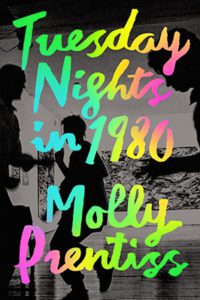
What happens when the thing we love most is taken from us? What rushes in to fill the gap? Do we ever completely recover?
These questions are threaded through the tender heart of Molly Prentiss’s debut novel Tuesday Nights in 1980. Prentiss sets her story in New York. And not just any New York, but the writ-large scene of Jean-Michel Basquiat, Cindy Sherman, Andy Warhol and Keith Haring. It’s New Year’s Eve, the last day of 1979, when we’re introduced to the cast. The stage is taut with the kind of energy you expect from a city on the cusp of change. The clock slips from one decade into the next. The champagne glasses rise. Life is exactly as it should be. Nothing has been stolen yet.
The narrative toggles among three main characters. James is an art critic for the New York Times whose gift of synesthesia gives him a discerning eye and an impeccable palate. “He wrote about everything he saw behind his eyes when he looked at art,” and “he jotted down the sensations he felt while looking at the work—Louise Fishman=strong smell of shampoo; Bill Rice=nocturnal mood, headache.” In his years as a critic he has amassed a collection of work that is the subject of immense envy in circles of elite dealers. Though socially a bit of a dope, his aesthetic taste greatly influences the culture around him.
Raul Engales is an immigrant painter with an inclination toward moodiness who escapes his sordid life in Argentina for a new kind of sordid life in New York (minus the political turmoil and family tragedy). His discipline and skill give him what the shrewd gallerist Winona George calls the next big thing. That’s “the” Winona George—“the one who had singlehandedly brought up some of the most revered (and now moneyed) artists, who had spoon-fed the art world digestible yet hearty helpings of neo-Expressionism, and who had reminded the world at large that art was and should be valuable.” She promises to drop Raul “like an anvil into the center of everything.”
Then there’s Lucy, a muse-like beauty from the Midwest who brushes the closest to a cliché. She moves to New York because “she wanted a whole life made out of stories: momentum, propulsion, characters, change.” Well, Lucy, you’re going to get all of those things in spades. James describes Lucy as “the deepest, most beautiful yellow.” Lucy comes to symbolize youth, desire, purity, and lust for the men who orbit around her like she’s a comet that is about to burn out. She idolizes artists without seeking to be one herself. What she aspires to be, it seems, is in love and in the midst of it all.
All three of these characters undergo profound losses that take them on a journey into the dark night of their souls. Both men lose talent, gifts, seemingly magic powers. What Lucy loses is not some integral piece of herself, but a man—a fact that might irk some of the more critical feminists among us. Is this yet another example of a woman defining herself through the men she loves?
As the lives of James, Raul, and Lucy converge and bump and bruise against each other, the men—brilliant and creative in their own right—manage to dig their ways out (mostly) of the messiness of tragedy. Lucy, however, is given the quietest and simplest ending. She is eaten up by the city and the men in it, proving the title of the chapter that introduces her correct: “A Girl in New York is a Terrible Thing.”
Through much of the book, Lucy is described through her body, the body of a young girl, because that body is where her power is. “She was a lime after a shot of strong tequila. She was no sunglasses and no sunscreen when you needed both. She was wet tar when your feet got stuck. Her mouth was all tongue and teeth… She was the feeling after laughter, which was the same as relief, which was the same as swimming. She had a starfish tongue, a bat’s body, a regal bowl of hair.”
The writing is gorgeous. There’s no doubt about that, but the image of Lucy as a girl who uplifts and then defiles underlines her role as a Madonna/whore figure in a long line of female characters that came before her. This is not to say the novel never reflects on Lucy’s predicament as a beautiful girl caught in a city run by men. It does reflect on this, like when Marge, James’s wife, confronts Lucy (kindly, generously) about the affair she has with her husband.
…she told Lucy to leave, with a quick and tearful lecture about what having dignity meant, especially as a beautiful woman. It isn’t enough to be beautiful… Beautiful is for other people. You have to be something for you.
Whether Lucy ever finds this elusive “something for you” is left for the reader to wonder.
It is certainly no surprise Prentiss has been collecting vigorous praise in the month since her novel was released. Tuesday Nights in 1980 exhibits a unique and sensitive command of language. It celebrates her ability to use unexpected images to invent new meaning inside familiar feelings. Prentiss does this while braiding together a plot-driven narrative about subjects we’ve seen a dozen times and will gladly see a dozen more if she’s the one doing the telling. This is a debut novel will that will poke at an ache inside you, and keeping you turning the page for more.





